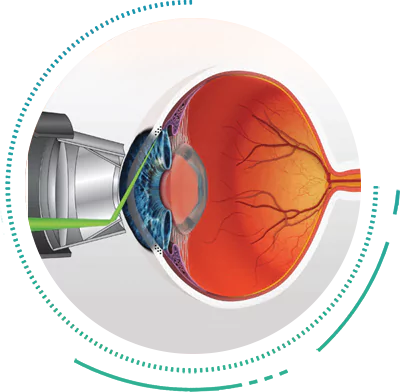Comprehensive Retina Service Near Me: Specialist Care for Your Vision
Recognizing the Different Vision Adjustment Procedures Available for Clearer View
In the realm of vision modification treatments, a multitude of choices exist to resolve refractive mistakes and give people with more clear sight. From the commonly identified LASIK surgical procedure to less invasive procedures like PRK and implantable lenses, the field of ophthalmology provides a variety of strategies tailored to suit different requirements and choices. Each treatment includes its very own collection of factors to consider, advantages, and prospective risks. Understanding the nuances of these vision adjustment approaches is important for making notified choices concerning one's visual health and wellness. Let's explore the complexities of these treatments and lost light on the course to accomplishing boosted vision quality.
LASIK Surgery
LASIK surgery is a common refractive treatment used to correct vision problems such as nearsightedness, astigmatism, and farsightedness. This medical technique, which stands for Laser-Assisted in Situ Keratomileusis, aims to reshape the cornea to enhance just how light is focused on the retina, inevitably improving vision quality.
One of the primary advantages of LASIK surgical treatment is the quick improvement in vision experienced by individuals. Lots of people discover a substantial improvement in their vision immediately after the procedure. Additionally, most individuals report marginal discomfort and pain during the surgical treatment and recuperation duration. The recuperation time for LASIK is fairly fast, with several individuals going back to their everyday tasks within a day or 2 post-operation. In general, LASIK surgery is a prominent option for people seeking a long-term service for their vision issues.
PRK Treatment
While likewise an usual refractive treatment, the PRK (Photorefractive Keratectomy) strategy differs from LASIK surgical procedure in its method to remedying vision problems. In PRK, as opposed to developing a flap on the cornea, the outer layer of the cornea, called the epithelium, is completely gotten rid of. This allows the laser to improve the cornea to fix refractive errors such as astigmatism, farsightedness, and nearsightedness directly externally.

In spite of the longer recuperation time, PRK can generate superb lead to vision enhancement, making it a beneficial choice for those that might not appropriate candidates for LASIK surgical treatment.
Implantable Lenses
Unlike PRK where the cornea is improved straight, implantable lenses supply another method for correcting vision by placing man-made lenses inside the eye. This treatment is especially helpful for individuals with high degrees of nearsightedness, astigmatism, or farsightedness who may not appropriate prospects for laser surgical procedures like LASIK or PRK.
Implantable lenses, additionally recognized as phakic intraocular lenses, job by supplementing the eye's all-natural lens with a fabricated one. glaucoma service near me. These lenses can be placed before the natural lens (former chamber) or behind the iris and in front of the all-natural lens (posterior chamber) By readjusting the power and positioning of these lenses, ophthalmologists can properly remedy refractive errors and enhance aesthetic skill
One advantage of implantable lenses is that they are exchangeable and detachable, providing versatility for future adjustments. As with any kind of surgical treatment, there are dangers entailed, such as infection or cataract development. Individuals thinking about implantable lenses should speak with an eye care expert to determine one of the most suitable alternative based upon their individual demands and eye health.
Corneal Rings
Corneal rings, additionally referred to as intracorneal ring segments, are little, transparent gadgets placed right into the cornea to fix vision distortions such as keratoconus. Keratoconus is a problem where the cornea thins and protrudes outward, triggering vision to become distorted. The insertion of corneal rings aids to flatten the cornea, boosting visual skill and reducing the uneven astigmatism brought on by keratoconus.
The procedure for placing corneal rings is fairly quick and minimally invasive, frequently executed as an outpatient procedure. During the surgical great post to read treatment, the ophthalmologist makes a little laceration in the cornea and inserts the rings at a specific depth. As soon as in position, the rings aid to improve the cornea, providing a smoother surface for light to enter the eye, which can result in clearer vision.
Corneal rings are taken into consideration a relatively easy to fix procedure, as they can be gotten rid of or changed if necessary. eyecare near me. While they might not entirely remove the need for glasses or contact lenses, corneal rings can significantly enhance vision high quality and general aesthetic convenience for people with keratoconus or various other corneal abnormalities
Refractive Lens Exchange
Complying with the modification of corneal irregularities with treatments like corneal rings, another vision adjustment method that can deal with refractive errors is Refractive Lens Exchange (RLE) RLE is a surgery that involves replacing visit this site the eye's all-natural lens with a fabricated intraocular lens (IOL) to deal with refractive mistakes such as farsightedness, nearsightedness, and presbyopia. This procedure is especially useful for individuals who may not be ideal prospects for procedures like LASIK or PRK due to aspects such as slim corneas or high refractive mistakes.

Verdict
In verdict, there are various vision correction treatments available to assist people attain more clear sight. LASIK surgery, PRK read what he said procedure, implantable lenses, corneal rings, and refractive lens exchange are all options that can deal with different vision issues.
In the realm of vision correction treatments, a plethora of alternatives exist to attend to refractive errors and offer individuals with more clear sight.LASIK surgery is a common refractive treatment utilized to fix vision problems such as farsightedness, nearsightedness, and astigmatism.While also an usual refractive procedure, the PRK (Photorefractive Keratectomy) technique varies from LASIK surgical treatment in its approach to dealing with vision issues.Following the improvement of corneal abnormalities with procedures like corneal rings, an additional vision modification technique that can address refractive mistakes is Refractive Lens Exchange (RLE) LASIK surgery, PRK treatment, implantable lenses, corneal rings, and refractive lens exchange are all choices that can address various vision concerns.